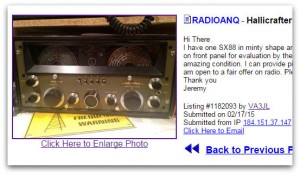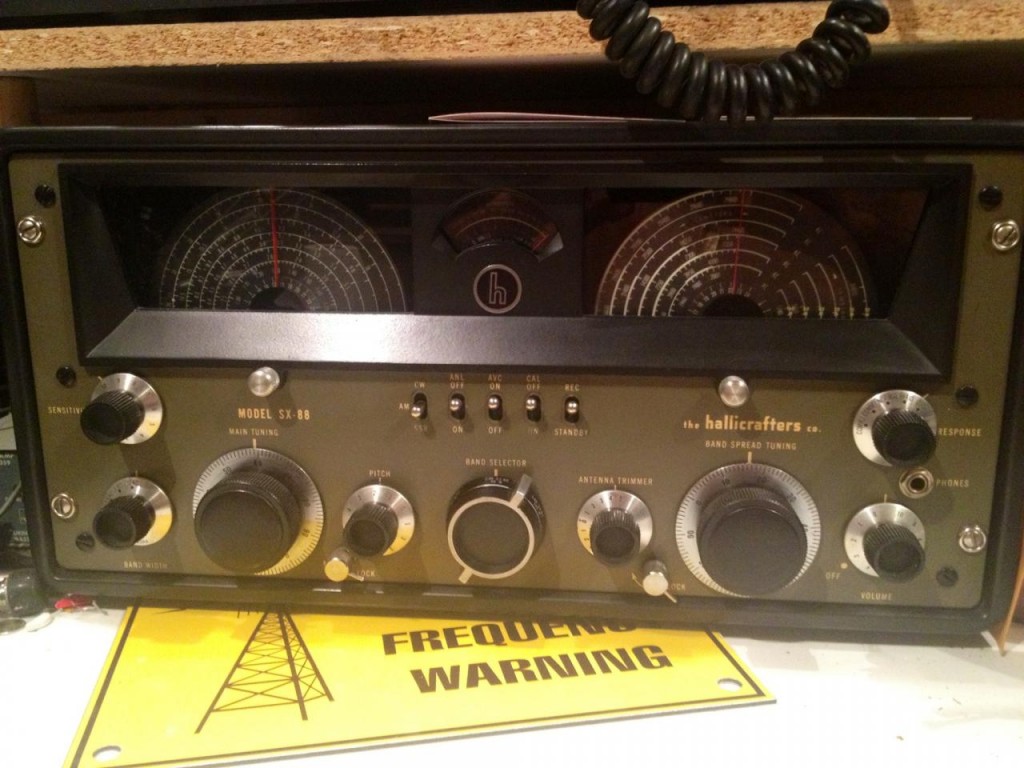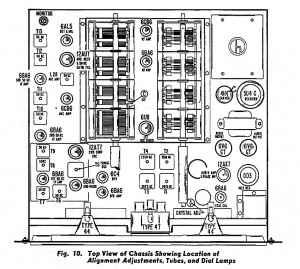 Cool map at N0HR.com
Cool map at N0HR.com
This is the world:
This is the world on Ham Radio:
By clicking on each country, you can find out how many Amateur Radio Ops that country claims.
72 de Larry W2LJ
QRP - When you care to send the very least!
Larry Makoski, W2LJ, is a regular contributor to AmateurRadio.com and writes from New Jersey, USA. Contact him at w2lj@arrl.net.
 Amateur Radio Newsline Report 1953 February 20 2015
Amateur Radio Newsline Report 1953 February 20 2015
- The IARU Region One Executive Committee meets to discuss issues affecting the future of ham radio
- The ARRL tells a broadband company to use caution experimenting on the High Frequency bands
- A radio club in Canada gets a government grant to expand its emergency repeater network
- The K1N Nevassa Island DXpedition comes to an end, so…now, which DXpedition moves up on the “Most Wanted” list?
THIS WEEK'S NEWSCAST
 Steve WG0AT test Drives the new LNR QRP rig
Steve WG0AT test Drives the new LNR QRP rig
Certainly sounds nice and looks good, doesn't it?
72 de Larry W2LJ
QRP - When you care to send the very least!
Larry Makoski, W2LJ, is a regular contributor to AmateurRadio.com and writes from New Jersey, USA. Contact him at w2lj@arrl.net.
 CLE191 Addendum
CLE191 Addendum
 |
| WC-332KHz - White Rock, BC |
From Neil (WØYSE):
WG2XSV (experimental callsign) will be running a CW beacon on 475.475 kHz for this event.
(In fact it is already running as of 0001 UTC 20 Feb).
Power is ~1 watt ERP (+/- 1 dB) from SW Washington State.
Reports appreciated to wØyse [at] ARRL[dot] net
I'm sure Neil would be delighted to receive any heard reports from his weekend CW beacon. Remember that this CLE also covers the 630m band and CW beacons that may be operational there.
If you know of any other 630m CW beacons that will be activated, please let me know and I will post the information here.
Also, CLE reports may be mailed to either myself, the CLE Yahoo list or to Brain Keyte, CLE organizer. Brian's address is: ndbcle@gmail.com
Reports should include your exact location (Lat/Long preferred or exact Gridsquare), your full name and e-mail address in case Brian needs to send an enquiry regarding your log.
The finer-details of CLE191 may be found in Wednesday's blog.
Lets hope conditions stay nice and quiet as they appear to be doing.
Steve McDonald, VE7SL, is a regular contributor to AmateurRadio.com and writes from British Columbia, Canada. Contact him at ve7sl@shaw.ca.
 US Islands Award Program
US Islands Award Program
For FAQ on the program - go here: http://www.usislands.org/USI-1DG-FAQ.pdf
Might be an excuse to get down to Long Beach Island for the day.
72 de Larry W2LJ
QRP - When you care to send the very least!
Larry Makoski, W2LJ, is a regular contributor to AmateurRadio.com and writes from New Jersey, USA. Contact him at w2lj@arrl.net.
 The Hallicrafters SX-88: a rare find and a gem of engineering
The Hallicrafters SX-88: a rare find and a gem of engineering
[Note: this post first appeared on my shortwave radio blog, the SWLing Post.]
Yesterday while glancing through the QTH.com classifieds ads, I noticed a rare boat anchor for sale: the Hallicrafters SX-88.
The seller, Jeremy, describes this SX-88 as follows:
Hi [t]here, I have one SX88 in minty shape and is one of a handful that came in military green on [the] front panel for evaluation by the military. This is an exceptional radio in amazing condition. I can provide pics for someone who is seriously interested. I am open to a fair offer on radio. Please, no low-ballers. We all know what [it’s] worth…
 “We all know what it’s worth“–?
“We all know what it’s worth“–?
Well, it just so happened that my good friend (and Elmer, or ham radio guru) Mike Hansgen (K8RAT) had recently provided me with a little history lesson on the subject of the SX-88, so I did know what this rig is worth: a great deal of money.
But curiosity got the best of me, so I contacted Jeremy (a nice fellow, by the way) and asked what he was expecting to receive in exchange for his Hallicrafters SX-88? Jeremy’s reply:
“…$5,500 USD will take it. It is a very rare unit; it was… only one of about 6 [painted green]…for presentation to the military for evaluation.
That price is firm. [I] will not negotiate downward, and shipping [from Ontario, Canada] is extra.”
After receiving this response from Jeremy, I happened to think that I have the reference guide to rare/used shortwave receivers: Fred Osterman’s Shortwave Receivers Past and Present 4th edition. (Click here for more info.)
Osterman’s wonderfully comprehensive guide mentions that the SX-88 is a “highly regarded, rare and collectible model.” As for the rarity of the SX-88, he describes it thus: “Extremely Scarce.” The used price range he gives is from $3,500-7,000 US.
I also have Chuck Dachis’ book, Radios By Hallicrafters; in it, he states that the SX-88 is, “the most sought-after Hallicrafters model.” Wow.
After thanking Jeremy for his response, he replied:
“It’s a lot of money for a receiver for certain, but it is a fantastic shortwave receiver as the audio that comes out of it is amazing.
It has 10 watts of audio and into a big speaker–it is second to none. The fidelity is amazing and it is the king of its kind. [For those who like] tube rigs, it is the best of its kind.
For ham purposes on AM it is amazing, and on CW I find it incredible to use.
[W]hen they built this thing they intended to pull all [the] stops out and build the best radio they could for the day with the military in mind. It was an engineering marvel for the day.
Anyway, I have played with it for years now and need to thin out the herd.”
Impressive. And while I just don’t have that kind of money to fork out for a receiver, I did ask myself the question: “If I had $5,500 to blow, would I get that Hallicrafters SX-88?”
And my answer? Yes. In fact, I would personally drive to Jeremy’s home in Ontario and bring it back; no way I’d trust it to a parcel carrier or the post office…
Come on, you may say. For a guy who rarely pays over $50 for a vintage receiver, how could you possibly justify that kind of financial and time commitment–?
Well, let’s think of it this way. I remember when when I paid well over two thousand for my first laptop in college. How much is it worth now? Maybe twenty dollars–?
Many people have retirement funds in investments, some of which are in a variety of innovative companies that they actually patronize–for example, Apple or Microsoft. But how often can you find an investment that you can actually play with? One which you can turn on, tune in, work the controls, and enjoy?
Yes, I’m sure this is just the sort of justification voiced by many a vintage car collector…So, why not for a museum-worthy radio? After all, they’re not making these anymore.
I expect this Halli will not only hold its value, but will probably increase in value over time.
Ah, well; fun to ponder. My question to you: Would you buy a $5,500 vintage receiver if you had it to spare?
If your answer is yes, and you do have the money, then you might want to contact Jeremy.
I’m very curious if there are any SX-88 owners among our readership? If so, please comment with your thoughts about the ’88!
And for the rest of us, just so we can revel in the vicarious pleasure of ownership, I’ve included some additional information about the Hallicrafters SX-88 below, including two videos.
Resources (courtesy of Jeremy):
[youtube http://www.youtube.com/watch?v=ozclVUwZ_mM]
[youtube http://www.youtube.com/watch?v=clF5HsewTnU]
Tom Witherspoon, K4SWL, is a regular contributor to AmateurRadio.com and writes from North Carolina, USA. Contact him at k4swl@qrper.com.
 AM on 28MHz and up
AM on 28MHz and up
Much to my surprise, the RSGB actually published my recent letter to their “The Last Word” column in RadCom, together with a (pathetic) reply from their Spectrum Chair. At least my letter was printed.
The response did nothing to address my concerns. Although the RSGB claims not to be anti-AM, you’d find this hard to believe with a look at the most recent band plans. AM has its place on all bands from 28MHz upwards. I just wish the RSGB and other national organisations would simply acknowledge that this mode has its place. It may be a minority interest mode, but in my experience it is the simplest mode from a building viewpoint.
Roger Lapthorn, G3XBM, is a regular contributor to AmateurRadio.com and writes from Cambridge, England.















